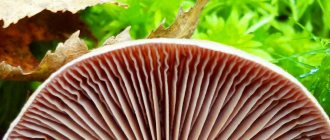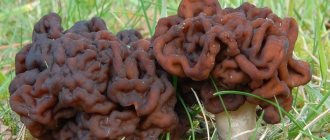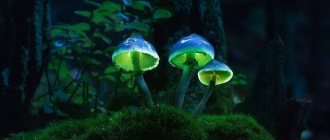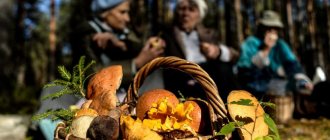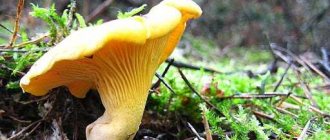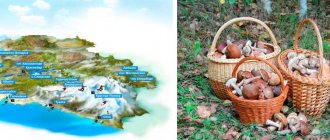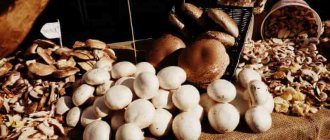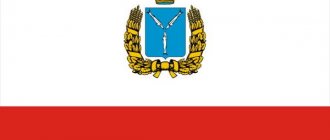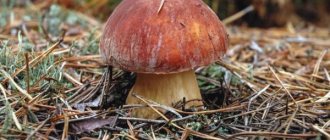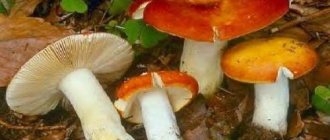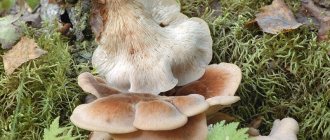Description
The mushroom got its name because of the specific surface of the cap, which seems to be covered with a layer of wax or frost.
Velvet flywheel.
hat
Small, up to 12 cm in diameter. The shape changes over time from hemispherical to cushion-shaped and even flat.
The cap is brown, maybe with a reddish tint; in overripe specimens it fades to beige or pinkish. The surface is velvety, dry, sometimes cracks, and covered with a waxy coating.
The moss is waxy.
Leg
12*2 cm in length and thickness respectively. Its color is yellow or red-yellow. The surface of the leg is smooth.
Spore powder
The spores are spindle-shaped, large, with a rough surface. The powder in the mass is yellowish.
The flywheel is frosty.
Spore-bearing layer
The hymenophore of the velvet mushroom is tubular. The color of the tubular layer ranges from yellow to green.
Pulp
Yellowish-white, when mechanically damaged and cut it turns blue. Taste and smell are rated quite highly.
Popular Edible Tube Mushrooms
Most of the mushrooms from this group are edible. They can be boiled, fried, pickled, dried and added to various dishes. Heat treatment does not reduce their beneficial properties and does not impair taste. Let's look at each of the edible specimens separately.
Bronze boletus
Bronze boletus is one of the most delicious and healthy mushrooms. It has a dark brown or almost black cap with a diameter of about 17 cm, velvety and soft to the touch. The leg of the bronze boletus is thick, strong, brownish in color, with a fine mesh on the surface.
Bronze boletus is a rare mushroom with high taste qualities.
It is not found often; its favorite habitat is deciduous forests.
Royal boletus
The real king of mushrooms, with excellent taste, is the royal boletus. It has a convex cap that is red, purple or pink. The older the mushroom, the paler its color. The leg grows to 6-8 cm in diameter, has a yellowish-brown color with a mesh pattern near the cap.
Royal boletus is highly valued for its dense and fragrant pulp.
Royal boletus grows in pine forests, but is sometimes found in deciduous forests.
Porcini
Porcini mushroom is the most valuable, has an exceptional taste and beneficial properties. Depending on the season, climate and ecology, the appearance of boletus mushrooms may vary, but they all have common structural features: a convex spherical cap and a massive leg, part of which is located underground. The color of the cap varies from deep brown to almost white.
The porcini mushroom is considered the most valuable, aromatic and nutritious.
Boletus grows everywhere except Antarctica and Australia, preferring coniferous, coniferous-deciduous forests.
Butter
Strong, appetizing mushrooms with ruddy caps are the closest relatives of the boletus mushroom. There are about 50 species of boletus in the world, differing from each other in appearance, place and timing of growth. The most common is the granular oiler, which is characterized by a convex or flat cap from dark brown to light orange in color and a creamy yellow leg strewn with small granular nodules.
Butterflies belong to the category of edible mushrooms and are found in the summer.
Butterflies love deciduous and swampy coniferous forests.
Mokhoviki
Moss fly mushrooms got their name for living in mosses. They have an easily recognizable golden-chocolate colored cap with light orange tubular flesh. The leg without a ring can be thin or thick depending on the growing conditions.
The flywheel mushroom got its name due to the growth of fruiting bodies in the moss.
A distinctive feature of the flywheel is that it turns blue when pressed or when cut.
boletus
Boletus trees are in symbiosis with birch trees. They are considered high quality mushrooms due to their valuable nutritional and taste characteristics. They have hemispherical caps with diameters up to 15 cm from white to brown, legs 20 cm high.
Boletus is a valuable mushroom that grows in deciduous forests, most often in birch forests
Boletus can be found in birch groves or in marshy areas where these trees are found.
Boletus
Boletuses are called so not only because of the area where they like to live, but also from the word “autumn”. This mushroom is easily confused with autumn foliage due to its bright red cap. Depending on the growing conditions, the boletus may have a different cap color. His leg is always white with dark scales. At the cut site it always acquires a dark blue or almost black tint.
Boletuses often grow in forests with mixed trees
Polish mushroom
This is an edible mushroom of the second category with a brown cap, which makes it look like a boletus or moss mushroom. Its pulp is fleshy and tasty, with a pleasant mushroom aroma. At the site of the incision, it begins to turn blue and darken.
The favorite habitat of the Polish mushroom is coniferous forest. Occasionally it can be found in deciduous forests, and even more rarely on stumps, fallen trees and the lower parts of the trunk.
The Polish mushroom is a prominent representative of the flywheel genus and is considered a delicacy product.
Duboviki
Dubovik grows under oak trees, in well-warmed limestone soil and belongs to the boletus family. It is similar to the boletus, but differs in the darker color of the cap and the dark mesh on the stem. The massive yellow flesh turns blue when cut and pressed.
Dubovik is an edible mushroom with high taste.
It is important not to confuse this edible and tasty mushroom with its inedible counterparts, which pose a serious danger to the human body.
Grabovik
This is a beautiful and noticeable mushroom, very similar to the boletus mushroom. The hornbeam has a brown cap that becomes dark gray or olive with age, and a thin white stalk with gray scales. Its flesh is pink with a purple tint.
It grows at the foot of the Caucasus Mountains and in the south of Russia; it is practically never found in central Russia.
Hornbeam is a unique mushroom that grows in deciduous forests
Similar species
- Motley moth fly.
It differs in that it is smaller in size, and its cap cracks more pronouncedly.
- Cysalpine moss.
It has a paler flesh color and smaller size.
1-Motley moth fly. 2-Moss fly cisalpine.
All of these “doubles” are edible, but are rated somewhat worse in terms of taste (they are all classified in the 4th category of nutritional value).
Poisonous and inedible tube mushrooms
Externally, inedible tubular mushrooms resemble edible ones, which is why they are called doubles. They have an unpleasant odor and bitter taste, and eating them leads to serious health consequences, including death.
Some poisonous mushrooms are used in medicine, for example, a choleretic drug is made from the gall mushroom.
Gall mushroom (lat. Tylopilus felleus)
The gall mushroom is also called false boletus, bitter or bitter. Outwardly, it really resembles a boletus, but is inedible. It has a large cap (diameter from 4 to 15 cm) in the shape of a hemisphere of brown, yellow-brown, chestnut or gray. Its leg is short and swollen, with a mesh pattern, the flesh is white and pink, and has a very bitter taste.
Gall mushroom is classified as inedible
False boletus grows in coniferous and deciduous forests, forming a symbiosis with oak, birch, spruce, and pine.
Pepper mushroom (Chalciporus piperatus)
Pepper mushroom (also called false mushroom) is inedible, but some scientists and lovers of “silent hunting” consider it a delicacy that only needs to be prepared correctly. This mushroom has a round cap with a diameter of about 7 cm. In young specimens it is convex, and straightens with age. The color of the cap ranges from dark rusty to light brown. The skin cannot be separated from the surface. The pulp is tubular, with brown elongated spores, yellowish in color.
When cut, the cap turns red and is characterized by a specific pungent taste with a peppery tint. The leg is cylindrical, about 8 cm long and up to 1.5 cm in diameter, often narrowed downward. Its color matches the color of the cap.
Pepper mushroom is conditionally edible due to its pungent taste
False moss mushrooms grow singly (rarely up to 3 pieces) near pines, forming mycorrhiza with them.
False satanic mushroom (Boletus splendidus)
Despite the fact that some consider the satanic mushroom to be conditionally edible, it should not be eaten. The toxic substances it contains can have a serious negative effect on the human body. It can be distinguished from edible mushrooms by its appearance. It will have a rounded cap with a diameter of 40-50 cm of gray, olive or brown color, a massive leg and dense tubular flesh, which will turn red when cut or pressed. It is the red tint of the pulp that should alert the mushroom picker, since this does not happen with edible specimens.
The false satanic mushroom is classified as inedible due to its toxic properties.
Satan's boletus (Boletus satanas)
This is a rare poisonous mushroom that is still little studied. It is very insidious, as it is similar in appearance to boletus, which is why inexperienced mushroom pickers may consider it edible. Satan is generally similar to the boletus: it has a velvety cap of gray, olive or almost white color, reaching 30 cm in diameter, and a thick short leg. But there are also several characteristic features that indicate its inedibility: the red color of the pulp when pressed or damaged, as well as the red-yellow leg.
The satanic boleth perfectly disguises itself as an edible species, but can cause serious poisoning
Satan's disease grows on sunny edges in coniferous and deciduous forests, sometimes choosing calcareous soil under oaks, chestnuts, and lindens.
Beautiful boletus (Boletus calopus)
The beautiful boletus is very poisonous. It is similar to the edible boletus, but differs from it in some features. The cap of a young mushroom is matte, fibrous, light brown, brown or gray in color; over time, it begins to change shape: it becomes convex and wavy at the edges. The tubular layer is yellow or olive, and begins to turn blue when cut. The leg has a reticulate pattern; in the middle part it is bright red, white at the base, and yellowish at the top. The flesh is firm, creamy, and turns blue when damaged. The taste of boletus is beautiful, at first sweetish, and then very bitter.
It is found in coniferous forests and at the foot of the mountains, where there are spruce trees; it is extremely rare to find it in deciduous forests.
The beautiful boletus is a bright and attractive, but poisonous mushroom that can lead to eating disorders
Rooting boletus (Boletus/Caloboletus radicans)
The root boletus is a poisonous tubular mushroom, similar in appearance to the edible boletus. It has a round cap with a diameter of about 30 cm with a smooth skin of light gray or greenish color, which turns blue when pressed. The pulp consists of small lemon-yellow tubes that turn blue when cut or pressed. The leg is swollen, lemon-yellow above and brown-olive below, covered with a reticulate pattern. The smell of the root boletus is pleasant, the taste is bitter.
The root boletus is inedible due to its bitter taste, so it is not eaten
Boletus is found rooting in deciduous forests, forming mycorrhiza with birch and oak.
Porphyry false birch
False birch porphyry (also known as “borer”) is very rare in nature and is even listed in the Red Book. This mushroom belongs to the tubular section and has a pinkish-yellow tubular layer. His hat is gray and turns red where it is cut. It is found in deciduous and coniferous forests, as well as some nature reserves.
Porphyritic pseudobirch is a rare species belonging to the conditionally edible mushrooms of the second category
Trametes Troga
Trametes Troga is an annual parasitic mushroom that grows on stumps, drying trees and dead trees. It can appear in the same place for several years in a row, forming white rot. The hats have a round or spread-bent shape. Soft hairs grow on their surface, the rest is hard and textured. The hymenophore is tubular, at first light gray or cream in color, and then brown or brownish-pink. The smell of Trametes Troga is pleasant, sometimes sour, and the taste is mild.
Trametes Troga is a parasitic spongy fungus that grows on old wood.
When going on a “silent hunt”, do not underestimate some types of tubular mushrooms. Their fleshy flesh and thick caps will appeal to many. The main thing is to learn to distinguish edible mushrooms from their inedible counterparts. It should also be taken into account that boletus, boletus, aspen and other types of trumpet mushrooms will bring maximum health benefits if they are prepared correctly.
By what signs do you distinguish edible mushrooms from inedible ones? Share your life hacks in the comments.
Interesting Facts
Xerocomellus pruinatus.
Some sources claim that the name “velvet” is not entirely true. In fact, the coating on the cap of this mushroom looks more like wax or frost. So it would be more accurate to call it “frosted”, which, by the way, is reflected in its Latin name - Xerocomellus pruinatus (pruina - literally “drizzle”). And the term Xerocomellus, literally meaning “moss fly”, consists of the words “dry” (Greek: Xersos) and “fluff” (Greek: kome).
Main differences from agaric mushrooms
Any cap mushroom has the main part of the fruiting body in the form of a cap. The cap contains organs that produce spore powder, and through spores, fungi reproduce. The shape of the cap may vary depending on the species and age. Young mushrooms have a round, ovoid or bell-shaped cap. This peculiar structure allows the fruiting body to easily break through the layer of soil and forest floor.
Most experienced mushroom pickers know what features distinguish lamellar mushrooms from tubular mushrooms. Below the pulp, all types of cap mushrooms have a spore-bearing layer, which is called hymenium and is located on the surface of the hymenophores. Tubular mushrooms have a hymenophore consisting of tubes or cells, while lamellar mushrooms have a hymenophore consisting of plates . Mushroom plates can be narrow and wide, thick and thin, frequent and rare. In tubulars, an important feature is represented by the color of the tubes, their shape and color, as well as the size of their holes.
Cooking methods and features
The most common and popular spongy or tubular types of edible mushrooms among mushroom pickers include boletus mushrooms, boletus mushrooms, boletus mushrooms, boletus mushrooms and boletus mushrooms. Their hat looks like a sponge and consists of many thin tubes. Spongy types are widely used in cooking, they can be:
- fry in oil or with sour cream;
- boil to prepare cold mushroom appetizers;
- stew with vegetables and herbs, as well as meat or fish;
- pickle and salt;
- dry for subsequent use in soups, porridges or fillings;
- freeze.
It is a well-known fact that it is tubular mushrooms that are recommended to be pickled and dried, since after processing they are able to retain their excellent taste and unique mushroom aroma. It should be noted that before carrying out any type of culinary processing, mushrooms must be carefully sorted by type and size, and then carefully cleaned of particles of soil and leaves, and cut off the roots.
After sorting, the fruiting bodies must be washed several times in running water for heat treatment and canning. Fruiting bodies prepared for drying should not be washed. It is recommended to marinate and salt the caps and legs separately . You can freeze both fresh and blanched, boiled or fried mushrooms.
Interesting information about the semi-white mushroom
Yellowjacket.
Despite the fact that the culinary properties of the semi-white mushroom are not much different from its “big brother”, the White mushroom, its cost in markets and procurement points is many times higher. This can only be explained by its striking appearance and rarity.
For a long time, the Semi-white mushroom in the regions where it is most often found was the “old man’s mushroom” - the younger generation ignored it because of its strong smell, and the old people, knowing that the smell was easy to eliminate by boiling, willingly collected it.
Where they grow, in what forests and how to collect
Moss fly mushrooms are distributed on two continents: Eurasia and Africa. They grow in almost all forests where there are green mosses. Locations and habitat conditions depend on the specific species. For example, the pan mushroom grows only in coniferous forests on light soils. It is most often found in Siberia, the Caucasus and North Africa. It can also be found in mixed forests in Europe.
Green moss mushroom grows in all types of forests. It is quite picky about soil and climate. The only constant condition for the growth of any flywheel is the presence of moss. Representatives of the semi-golden species can be found in the Caucasus and the Far East.
Moss mushrooms appear above the ground already in early July, however, they can be collected no earlier than August. The edibility of the fruit is indicated by the appearance of blue discoloration in the damaged area. If it is not there, the fruit may be too bitter.
Distribution and collection
The semi-white mushroom is a rather rare species in the mushroom picker’s basket. This species is thermophilic, therefore it is extremely rare in Central Russia.
Much more often it can be found in the southern regions of our country, in the Carpathian region. Prefers clay soils with lime admixtures, damp places, clearings with a predominance of deciduous trees, especially beech. It often also grows under hornbeam, pine or oak.
Yellow boletus.
Recently it has become so rare that it is close to being included in the Red Book species.
Features of sponge mushrooms
These organisms belong to the group of basidiomycete fungi, endowed with a special structure of the fungal body. Tubular or sponge mushrooms are so named because of the structural features of the hymenophore, which looks like a sponge. It consists of small cells with holes in which spores ripen. This structure gives the lower part of the cap of the fruiting body softness and springiness.
Sponge species include representatives that grow on the ground in symbiosis with plant roots. Tinder fungi are parasitic forms that choose living trees as a substrate. The appearance of the latter differs slightly from the standard one in the absence of a visible stalk, a larger cap and a hymenophore that is difficult to separate from its lower surface.
Varieties of edible fly mushrooms
There are several types of moss mushrooms that have excellent taste and pleasant aroma. They all have certain external features that make them easy to recognize.
Polish (pan) mushroom
Polish moss has several names, including Pansky and chestnut. It is most valued in European countries. It has a fairly large body: the diameter of the top can be from 12 to 15 cm. It has a rich yellow-brown color. The context has a pronounced aroma and delicate taste.
Moss fly red
The red moth is a fairly large species that is difficult to miss in the forest. Its upper part can reach a diameter of 9 cm. The height of the stem is usually equal to the diameter of the cap. The inner layer is fleshy and fibrous, with a lemony tint. If you press on the sporocarp or cut it, the damaged area will turn blue. This means that the fruit is an edible species.
Green moss
A distinctive feature of this species is the unusual yellow-brown color of the cap. It reaches 10 cm in diameter. The leg looks like a cylinder with a wider base. The inside is light, dense to the touch, with a rich aroma.
Motley flywheel (cracked)
The species owes its name to the large number of small cracks on the cap. The motley moth fly is inferior in size to its relatives: the diameter of the upper part is only 3-7 cm. The color can be either gray or burgundy. The leg looks like a mace.
